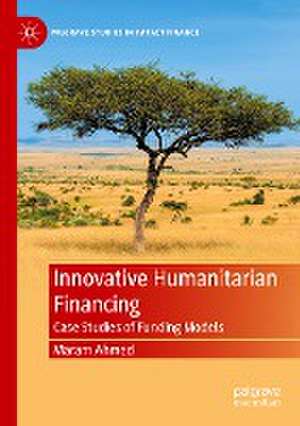Innovative Humanitarian Financing: Case Studies of Funding Models: Palgrave Studies in Impact Finance
Autor Maram Ahmeden Limba Engleză Paperback – 20 oct 2022
| Toate formatele și edițiile | Preț | Express |
|---|---|---|
| Paperback (1) | 687.30 lei 6-8 săpt. | |
| Springer International Publishing – 20 oct 2022 | 687.30 lei 6-8 săpt. | |
| Hardback (1) | 699.45 lei 6-8 săpt. | |
| Springer International Publishing – 19 oct 2021 | 699.45 lei 6-8 săpt. |
Din seria Palgrave Studies in Impact Finance
-
 Preț: 319.44 lei
Preț: 319.44 lei - 18%
 Preț: 991.24 lei
Preț: 991.24 lei - 18%
 Preț: 1002.31 lei
Preț: 1002.31 lei -
 Preț: 484.85 lei
Preț: 484.85 lei - 15%
 Preț: 690.44 lei
Preț: 690.44 lei - 18%
 Preț: 720.22 lei
Preț: 720.22 lei - 18%
 Preț: 898.58 lei
Preț: 898.58 lei - 18%
 Preț: 947.98 lei
Preț: 947.98 lei - 18%
 Preț: 943.88 lei
Preț: 943.88 lei - 18%
 Preț: 999.45 lei
Preț: 999.45 lei - 18%
 Preț: 937.86 lei
Preț: 937.86 lei - 18%
 Preț: 778.63 lei
Preț: 778.63 lei -
 Preț: 422.90 lei
Preț: 422.90 lei - 18%
 Preț: 942.31 lei
Preț: 942.31 lei - 15%
 Preț: 701.06 lei
Preț: 701.06 lei - 18%
 Preț: 996.91 lei
Preț: 996.91 lei - 18%
 Preț: 948.92 lei
Preț: 948.92 lei -
 Preț: 397.99 lei
Preț: 397.99 lei - 15%
 Preț: 688.96 lei
Preț: 688.96 lei - 15%
 Preț: 702.05 lei
Preț: 702.05 lei -
 Preț: 417.30 lei
Preț: 417.30 lei - 18%
 Preț: 998.66 lei
Preț: 998.66 lei - 15%
 Preț: 686.18 lei
Preț: 686.18 lei - 18%
 Preț: 733.33 lei
Preț: 733.33 lei -
 Preț: 452.79 lei
Preț: 452.79 lei - 18%
 Preț: 941.34 lei
Preț: 941.34 lei - 18%
 Preț: 736.01 lei
Preț: 736.01 lei - 15%
 Preț: 640.06 lei
Preț: 640.06 lei - 15%
 Preț: 642.36 lei
Preț: 642.36 lei - 18%
 Preț: 892.59 lei
Preț: 892.59 lei
Preț: 687.30 lei
Preț vechi: 808.58 lei
-15% Nou
Puncte Express: 1031
Preț estimativ în valută:
131.51€ • 137.68$ • 108.82£
131.51€ • 137.68$ • 108.82£
Carte tipărită la comandă
Livrare economică 05-19 aprilie
Preluare comenzi: 021 569.72.76
Specificații
ISBN-13: 9783030832117
ISBN-10: 3030832112
Pagini: 243
Ilustrații: XI, 243 p. 1 illus.
Dimensiuni: 148 x 210 mm
Greutate: 0.31 kg
Ediția:1st ed. 2021
Editura: Springer International Publishing
Colecția Palgrave Macmillan
Seria Palgrave Studies in Impact Finance
Locul publicării:Cham, Switzerland
ISBN-10: 3030832112
Pagini: 243
Ilustrații: XI, 243 p. 1 illus.
Dimensiuni: 148 x 210 mm
Greutate: 0.31 kg
Ediția:1st ed. 2021
Editura: Springer International Publishing
Colecția Palgrave Macmillan
Seria Palgrave Studies in Impact Finance
Locul publicării:Cham, Switzerland
Cuprins
Chapter 1: Introduction.- Chapter 2: Humanitarian Funding in Crisis and The Rise of Innovative Humanitarian Finance.- Chapter 3: Innovative Vaccine and Immunization Funding: Advance Market Commitment.- Chapter 4: Performance Based Financing.- Chapter 5: Islamic Finance: Role of Traditional Faith-Based Mechanisms in Humanitarian Response.- Chapter 6: Financial Inclusion: Increasing Resilience by Expanding Access to Financial Services.- Chapter 7: Case Study: African Risk Capacity.- Chapter 8: Remittances.- Chapter 9: Harnessing Digital Financial Solutions.- Chapter 10: Conclusion.- Index.
Notă biografică
Maram Ahmed teaches at the Faculty of Law and Social Sciences, SOAS, University of London. Maram has published in various key academic and policy journals and has also published and been featured in mainstream media publications such as the Financial Times, CNBC, Reuters, the World Economic Forum, Devex and others. Maram frequently speaks at conferences and industry summits across the globe and has worked internationally with a range of government, corporate and humanitarian agencies. To find out more, visit www.maramahmed.com.
Textul de pe ultima copertă
Humanitarian crises have become more frequent, complex and protracted. If current trends continue, it is estimated that by 2030, humanitarian assistance costs could increase to $50 billion per year. By then, two-thirds of the world’s poor are at risk of living in conflict-affected countries. To bridge the gap, humanitarian organizations are increasingly utilizing innovative financing tools such as impact bonds, faith-based finance and other innovative financial products and services to mobilize greater funding to address humanitarian needs. This book is among the first to assess a set of innovative financing mechanisms that have been transforming the humanitarian sector and explores their key opportunities, challenges and future prospects. This book will be of interest to academics, practitioners, humanitarian organizations and policy makers involved in humanitarian financing and to the humanitarian sector in general.
Maram Ahmed teaches at the Faculty of Law and SocialSciences, SOAS, University of London. Maram has published in various key academic and policy journals and has also published and been featured in mainstream media publications such as the Financial Times, CNBC, Reuters, the World Economic Forum, Devex and others. Maram frequently speaks at conferences and industry summits across the globe and has worked internationally with a range of government, corporate and humanitarian agencies. To find out more, visit www.maramahmed.com.
Maram Ahmed teaches at the Faculty of Law and SocialSciences, SOAS, University of London. Maram has published in various key academic and policy journals and has also published and been featured in mainstream media publications such as the Financial Times, CNBC, Reuters, the World Economic Forum, Devex and others. Maram frequently speaks at conferences and industry summits across the globe and has worked internationally with a range of government, corporate and humanitarian agencies. To find out more, visit www.maramahmed.com.
Caracteristici
Provides a road map of priorities and policy strategies for further development The first to assess a set of innovative financing mechanisms Explores the range of non-traditional financing mechanisms and approaches
